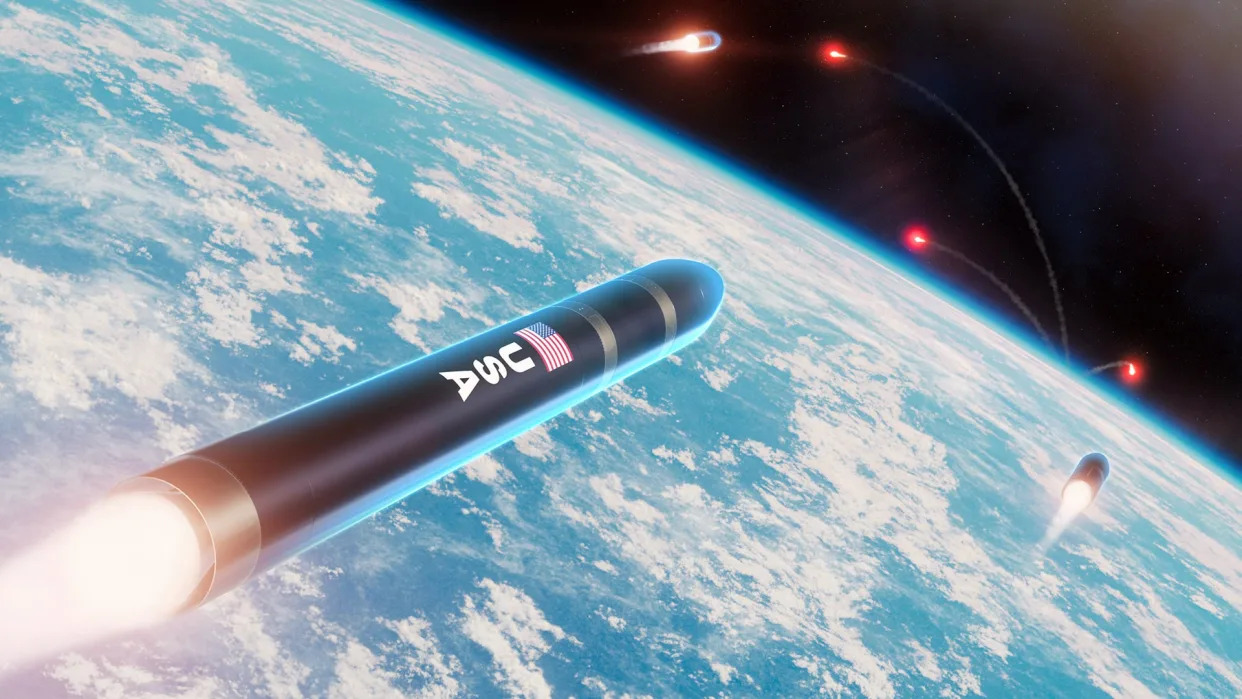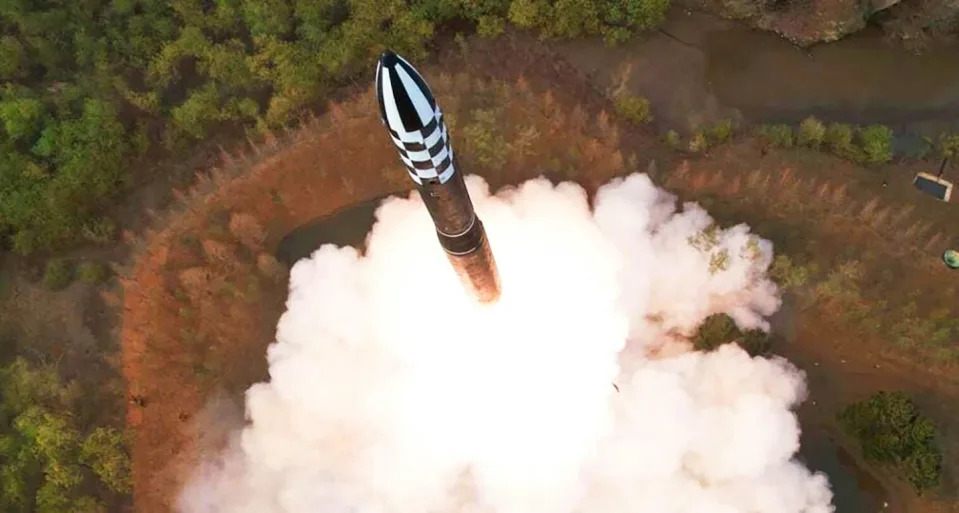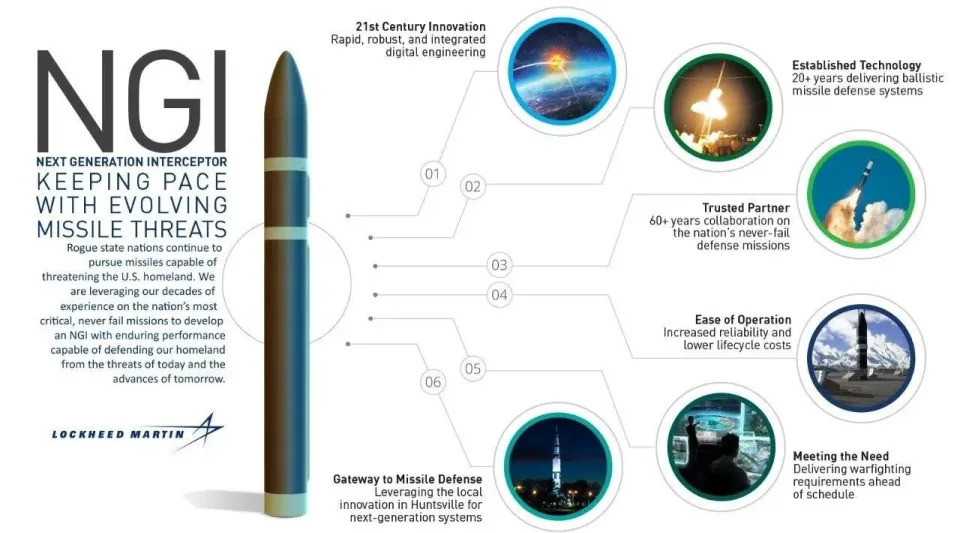Howard Altman
Tue, June 11, 2024

Artist rendering of NGI in flight.
The White House does not want to see a third ballistic missile interceptor site created on the East Coast in addition to the ones already in operation in Alaska and California.
“There is no operational need for such a site to protect the Homeland against potential ballistic missiles originating from Iran or the Democratic People’s Republic of Korea (DPRK),” the White said in its “Statement on Administration Policy.”

North Korea Solid Fuel HWASONG18 ICBM. KCNA
The Biden administration is “strongly” opposing a measure in the House Armed Services Committee's (HASC) Fiscal Year 2025 National Defense Authorization Act legislation calling for the establishment by December 2030 of an “additional continental United States interceptor site, located at the Department of Defense’s conditionally designated preferred site of Fort Drum, New York.”
In arguing for the Fort Drum site, HASC had an opposite take from the White House, stating that it is “needed to enhance the protection of the United States homeland against potential long-range ballistic missiles originating from Iran or North Korea.”
HASC also mandated that the Missile Defense Agency (MDA) begin providing an annual report, starting no later than Dec. 31, about the status of the planning and design, construction, development, and equipment requirements for the interceptor site. In addition, the committee wants to know plans for deploying additional missile defense sensor discrimination capabilities there.
The HASC legislation does not include a price tag, but last year, then-Joint Chiefs Chairman Mark Milley told Congress it “would take billions; I don't know exact cost figures, but take billions,” to build the Fort Drum interceptor site.
The U.S. now has two launch sites already established to counter long-range ballistic missile threats; the primary one at Fort Greely, Alaska, and a smaller one at Vandenberg Air Force Base, California. The missiles are Ground-Based Interceptors or GBIs.

A Ground-Based Interceptor. US Army
GBIs are part of the U.S. military's Ground-based Midcourse Defense missile defense system (GMD). GMD is designed to physically knock out long-range ballistic missile threats to the U.S. homeland while they are still in space. The entire GMD system architecture ties into a network of ground-, sea-, and space-based sensors and command and control systems. You can read all about how midcourse intercept works in this past explainer of ours.
The White House said that the existing sites will be sufficient to counter threats under the planned Next Generation Interceptor (NGI) program, which will ultimately replace the GBI. You can read much more about that program in our deep dive that questioned its exorbitant nearly $20 billion price tag here.

An infographic from Lockheed Martin on its NGI design., Lockheed Martin
The Pentagon “has prioritized improving the probability of successfully intercepting missile threats by completing development” of NGI, “ which will begin fielding in 20 available silos in Alaska in 2028,” the White House stated. “The NGI will protect all 50 states, the District of Columbia, the U.S. Virgin Islands, and Puerto Rico against existing threats from the DPRK and potential future threats. The Department will continue to monitor developments in these threats and evolutions in the capability of the nation’s Ballistic Missile Defense System.”
The NGI is a multiple-kill vehicle interceptor "hit-to-kill" kinetic weapon designed to destroy its targets by smashing into them outside the Earth's atmosphere. By contrast, the GBI features a single Exoatmospheric Kill Vehicle (EKV) that engages a single target. You can see a successful test of a GBI last year in the video below.
https://youtu.be/kxRDK2SYSlg?t=3
Multiple kill vehicles allow the NGI to engage more than one target at a time or assign more than one kill vehicle to an incoming target. That’s a big advantage over single-kill vehicle interceptors like the GBI, especially given the very limited numbers being produced. This will allow for better effectiveness defending against multiple missile attacks. This all relies on a multitude of sensors, from the sea to space, to help detect, classify and guide the warhead to the target or targets. The Pentagon’s developing satellite-based space tracking layer, which provides global indications, warning, tracking, and targeting of advanced missile threats, should eventually help make these engagements more seamless and less reliant on terrestrial sensors.
The Pentagon is asking for more than $2.5 billion in the Fiscal Year 2025 budget for the GMD program. That includes continuing NGI All-Up Round (AUR) development “to enhance homeland defense interceptor capability and capacity to increase current fleet size to 64 interceptors (44 GBIs and 20 NGIs) as early as the end of the decade.”
NGI funding provides for “the analysis, design, development, prototyping, integration and relevant environment testing to mature the booster, payload, sensor, and design-specific critical technologies and technology elements,” of the weapon, according to the Pentagon. It also “upgrades and consolidates ground testing infrastructure and facilities” as well as upgrades and replaces “ground system infrastructure fire control/kill vehicle software to improve the reliability and cybersecurity resiliency of the GMD weapon system.” In addition, it funds “Ground, Cyber and Flight testing to support the Integrated Master Test Plan.”

A notional rendering of the Next Generation Interceptor. Lockheed Martin
In April, the Missile Defense Agency (MDA) downselected Lockheed Martin to be the prime contractor on the $17.8 billion NGI program. That was after MDA awarded development contracts for NGI to Lockheed Martin and Northrop Grumman in March 2021.
That's a very large price tag for a program that, as of now, includes just delivered 20 interceptors. As it sits, NGI will augment GBI, but there are hopes that it would replace the latter entirely as those older interceptors age out and become less operationally relevant.
While existing North Korean ballistic missile technology can reach the entirety of the United States, the reliability of its reentry vehicles and nuclear warheads remains in question. North Korea's rapid expansion of its nuclear arsenal and long-range missile inventory has also drawn concerns that it could numerically outpace the GMD system in the not too distant future. As for Iran, it is developing its long-range ballistic capabilities as well but has yet to design one that can reach more than 1,200 miles.
Some have argued that a greater amount of focus is needed on securing the homeland against lower-end conventional threats, like long-range attack drones and cruise missiles, than against ICBMs. America’s GMD capability can only work against low-volume nuclear missile attacks by rogue states, not major powers like China and Russia.
NGI, which won’t come online until 2028 at the earliest, has yet to be flight-tested. The U.S. has made a huge bet that it will be able to add to and possibly replace GBI to meet North Korean and Iranian threats.
Contact the author: howard@thewarzone.com
No comments:
Post a Comment